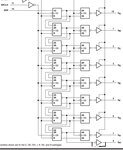varunme
Advanced Member level 3

Last edited:
Follow along with the video below to see how to install our site as a web app on your home screen.
Note: This feature may not be available in some browsers.








I shorted the shift clock and latch clock, so it uses only two pins
it works in proteus, but in real hardware, not
i added 1uf in QH' to gnd, same result

It "works" in a way that all output pins get same data...I shorted the shift clock and latch clock, so it uses only two pins it works in proteus.


sbit SR_Latch at RC1_bit;
//sbit SR_Enable at RC2_bit;
sbit SR_Latch_Direction at TRISC1_bit;
//sbit SR_Enable_Direction at TRISC2_bit;
void main() {
trisc=0;
trisD=0;
portc=0;
portd=0;
SPI1_Init();
while(1) {
long a=0b00000001000001000000000000000111;
//SPI1_Write(0b00000001);
//SPI1_Write(a>>24);
SPI1_Write(a>>16);
SPI1_Write(a>>8);
SPI1_Write(a);
SR_Latch = 1;
PORTC.F0=1;
PORTD.F2=0;
delay_ms(1000);
SR_Latch = 0;
PORTC.F0=0;
PORTD.F2=0;
a=0b11110000000000000000000000000000;
//SPI1_Write(0b00001000);
//a=~a;
//SPI1_Write(a>>24);
SPI1_Write(a>>16);
SPI1_Write(a>>8);
SPI1_Write(a);
SR_Latch = 1;
PORTC.F0=1;
PORTD.F2=1;
delay_ms(1000);
SR_Latch = 0;
PORTC.F0=0;
PORTC.F2=0;
}
}

That capacitor has to be connected between QH' and which pin?

if ((_BV(i) & __led_state) == _BV(i))
Code C - [expand]


switch(uart_rd){
case1: x=0b000011100011001;
case2: x=0b000011100011001;
casea: x=0b000011100011001;
caseb: x=0b000011100011001;
Code C - [expand]